ScanGoogle.ru virus (Removal Guide) - Chrome, Firefox, IE, Edge
ScanGoogle.ru virus Removal Guide
What is ScanGoogle.ru virus?
ScanGoogle.ru will hijack your homepage and use you for generating pay-per-click revenue
ScanGoogle.ru virus is a name given to a deceptive search engine which takes over computer browsers, replaces homepages and becomes their default search engine without user’s consent. This search platform is based on Custom Google Search [1] which allows the service creators to choose what specific content will be displayed in the search results. In the case of Scan Google, its focus is on the sponsored content, ads, and other links that would generate traffic on various third-party websites. The role of the user is to click on this content and generate pay-per-click revenue [2] for the search provider. The correlation here is pretty simple: the more computers this virus manages to infect, the more clicks unsuspecting users generate and the more profitable this project becomes. Such shady behavior is probably the core reason why we can’t find any information about the search provider, EULA or Privacy Policy on this website. The only interesting thing we have managed to find is that this site employs Yandex.Metrica counter to monitor its traffic and other analytics. The absence of basic information about the service or its provider already signals there’s something wrong and should encourage everyone to remove ScanGoogle.ru from their computers right away. FortectIntego may come in handy for a quick virus removal.
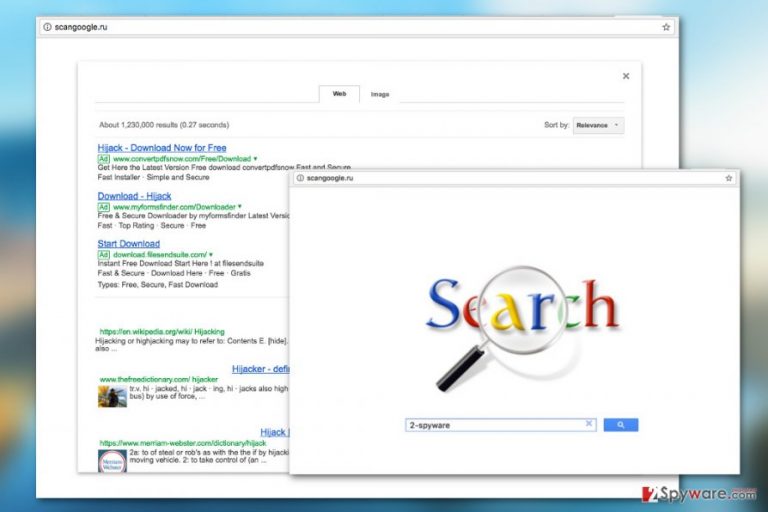
What he haven’t already mentioned about this virus is that it is not only interested in user’s behavior on the site itself but also outside of it. The malware may install additional toolbars, browser extensions or add-ons on the computer to help track various information about user’s browsing habits. Typically, programs which are categorized as browser hijackers collect non-personally identifiable data about user’s search queries, most visited websites, viewed pages and similar statistics. Such information can later be used to redirect users to specific websites or display targeted ads. If you’d rather have the search service work for you instead of the opposite, you undoubtedly have to perform ScanGoogle.ru removal and opt for some different web search provider.

PUPs rely on deceptive software marketing techniques to infect computers
ScanGoogle.ru can be found hiding inside freeware and shareware packages. This method makes the hijack really easy because of the users’ tendency to install new software rather recklessly. The installation wizards are a total bore to the cyber community and the majority of people simply choose Quick installation just to get over the whole process faster. Thus, the malware creators bundle ScanGoogle.ru with freeware and shareware, knowing that its installation will most likely be successful. If you care about your computer’s protection and want to ban unwanted applications from making their way into your system, choose “Advanced” mode when installing new programs and go through each installation step carefully.
Remove ScanGoogle.ru and prevent your system from other PUPs
There are basically two ways to remove ScanGoogle.ru virus from the infected computer. You can do it manually or automatically, with the help of some trusted antivirus tool. If you feel put off by the idea of dealing with the hijacker manually, you can always pass the virus to the hands of security professionals and launch an anti-malware utility which will locate and exterminate all the virus components for you. Nevertheless, if you are willing to take one step further and try to perform ScanGoogle.ru removal yourself, please follow the professional elimination guide below.
You may remove virus damage with a help of FortectIntego. SpyHunter 5Combo Cleaner and Malwarebytes are recommended to detect potentially unwanted programs and viruses with all their files and registry entries that are related to them.
Getting rid of ScanGoogle.ru virus. Follow these steps
Uninstall from Windows
ScanGoogle.ru virus is a virus that no one wants to see on their computers. In case it managed to sneak into your system, and you don’t have the antivirus software to remove it, you can follow the guidelines below and banish the virus from your PC manually:
Instructions for Windows 10/8 machines:
- Enter Control Panel into Windows search box and hit Enter or click on the search result.
- Under Programs, select Uninstall a program.
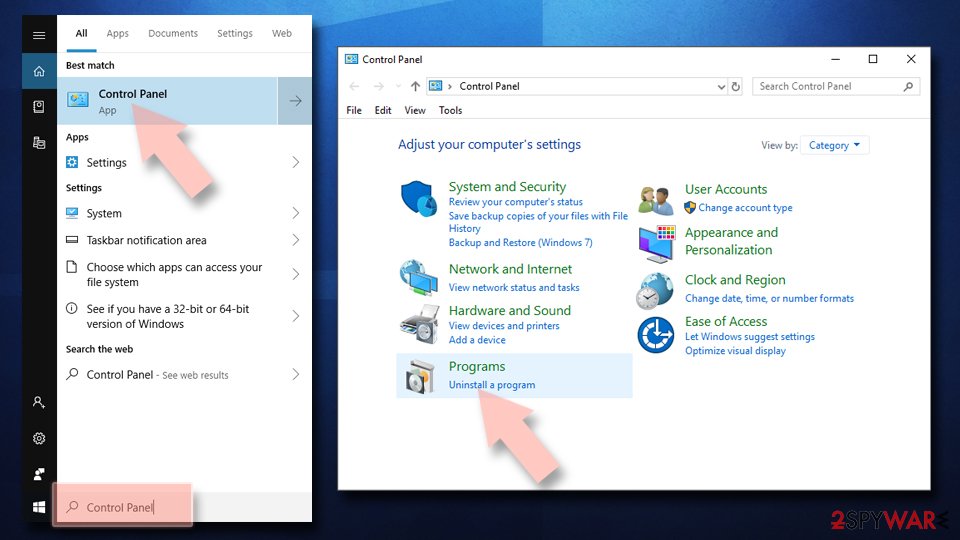
- From the list, find the entry of the suspicious program.
- Right-click on the application and select Uninstall.
- If User Account Control shows up, click Yes.
- Wait till uninstallation process is complete and click OK.
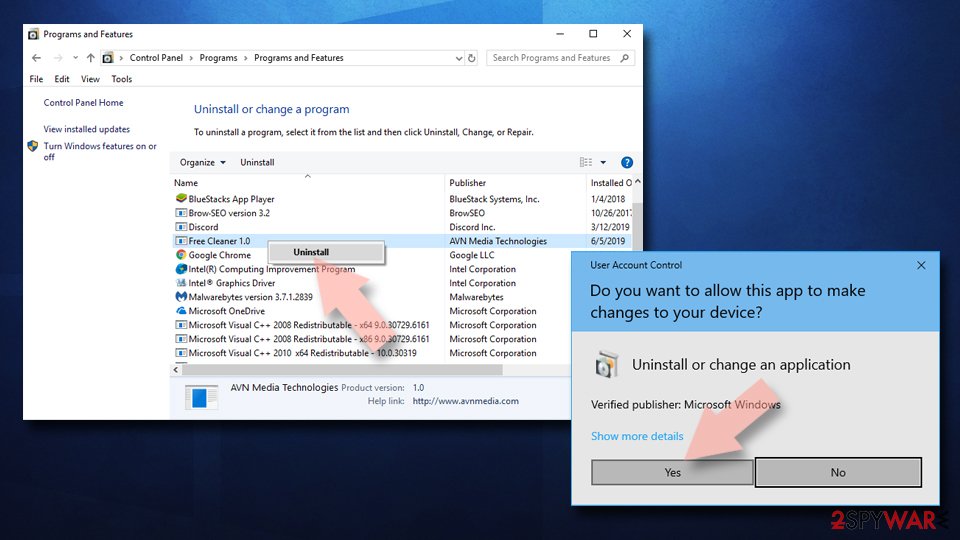
If you are Windows 7/XP user, proceed with the following instructions:
- Click on Windows Start > Control Panel located on the right pane (if you are Windows XP user, click on Add/Remove Programs).
- In Control Panel, select Programs > Uninstall a program.

- Pick the unwanted application by clicking on it once.
- At the top, click Uninstall/Change.
- In the confirmation prompt, pick Yes.
- Click OK once the removal process is finished.
Delete from macOS
Remove items from Applications folder:
- From the menu bar, select Go > Applications.
- In the Applications folder, look for all related entries.
- Click on the app and drag it to Trash (or right-click and pick Move to Trash)
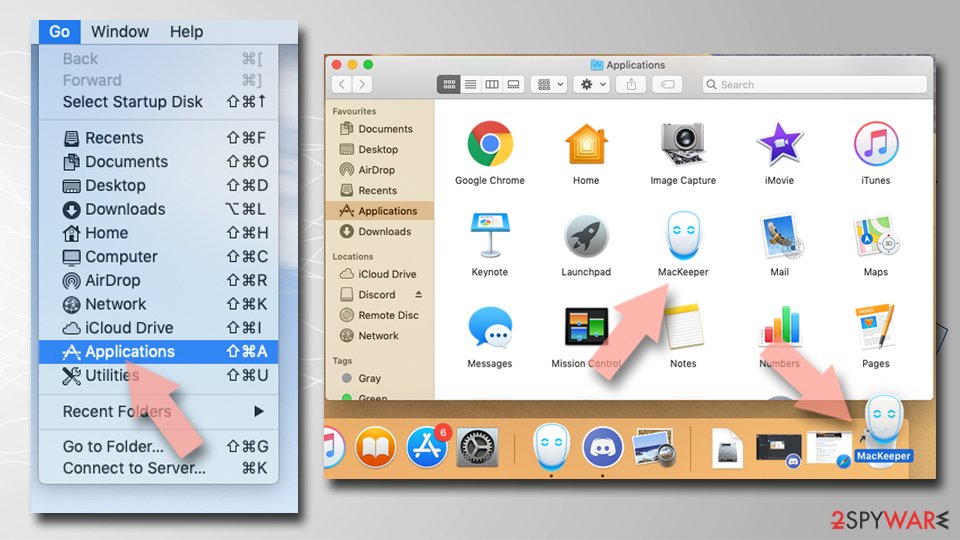
To fully remove an unwanted app, you need to access Application Support, LaunchAgents, and LaunchDaemons folders and delete relevant files:
- Select Go > Go to Folder.
- Enter /Library/Application Support and click Go or press Enter.
- In the Application Support folder, look for any dubious entries and then delete them.
- Now enter /Library/LaunchAgents and /Library/LaunchDaemons folders the same way and terminate all the related .plist files.

Remove from Microsoft Edge
Hijackers may leave some trace on the web browsers even when they are deleted from the system itself. Therefore, it recommended to reset web browsers to complete the removal.
Delete unwanted extensions from MS Edge:
- Select Menu (three horizontal dots at the top-right of the browser window) and pick Extensions.
- From the list, pick the extension and click on the Gear icon.
- Click on Uninstall at the bottom.
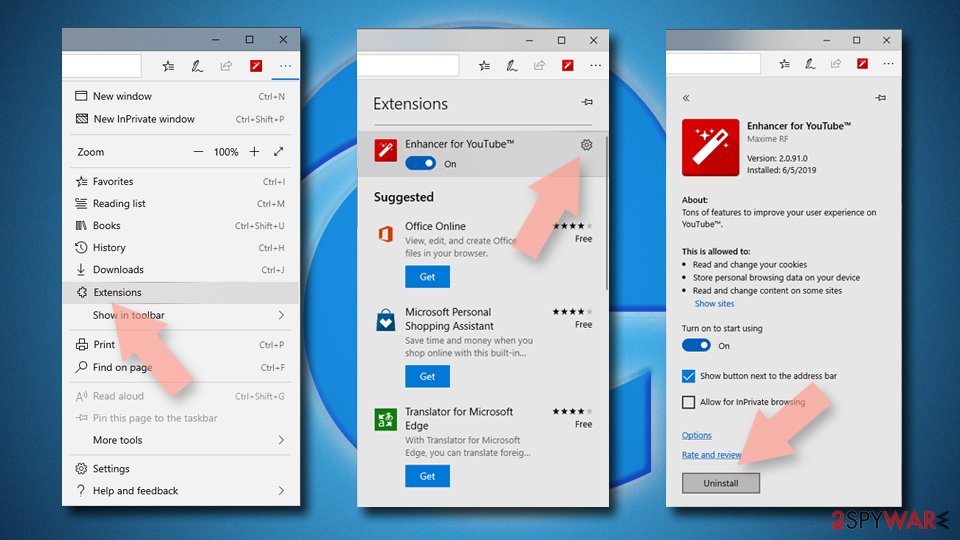
Clear cookies and other browser data:
- Click on the Menu (three horizontal dots at the top-right of the browser window) and select Privacy & security.
- Under Clear browsing data, pick Choose what to clear.
- Select everything (apart from passwords, although you might want to include Media licenses as well, if applicable) and click on Clear.
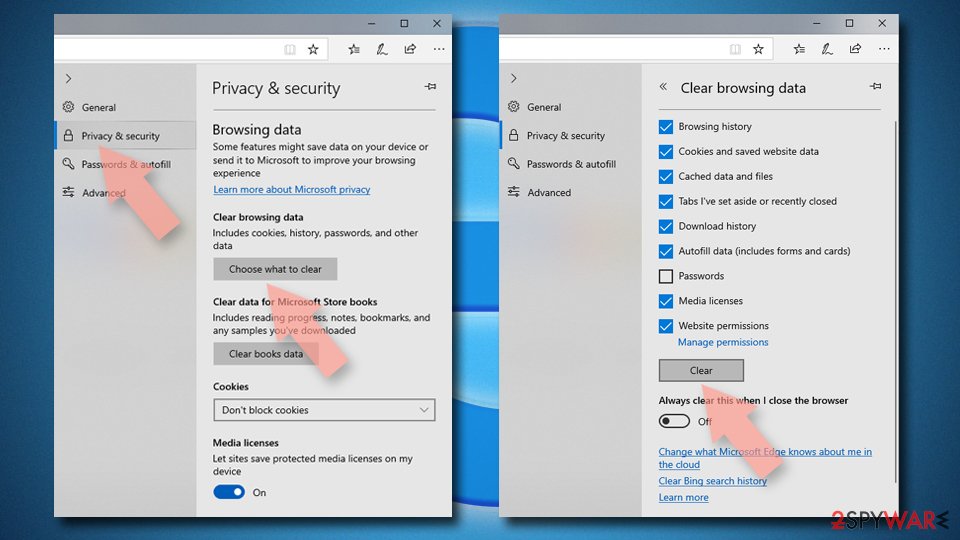
Restore new tab and homepage settings:
- Click the menu icon and choose Settings.
- Then find On startup section.
- Click Disable if you found any suspicious domain.
Reset MS Edge if the above steps did not work:
- Press on Ctrl + Shift + Esc to open Task Manager.
- Click on More details arrow at the bottom of the window.
- Select Details tab.
- Now scroll down and locate every entry with Microsoft Edge name in it. Right-click on each of them and select End Task to stop MS Edge from running.
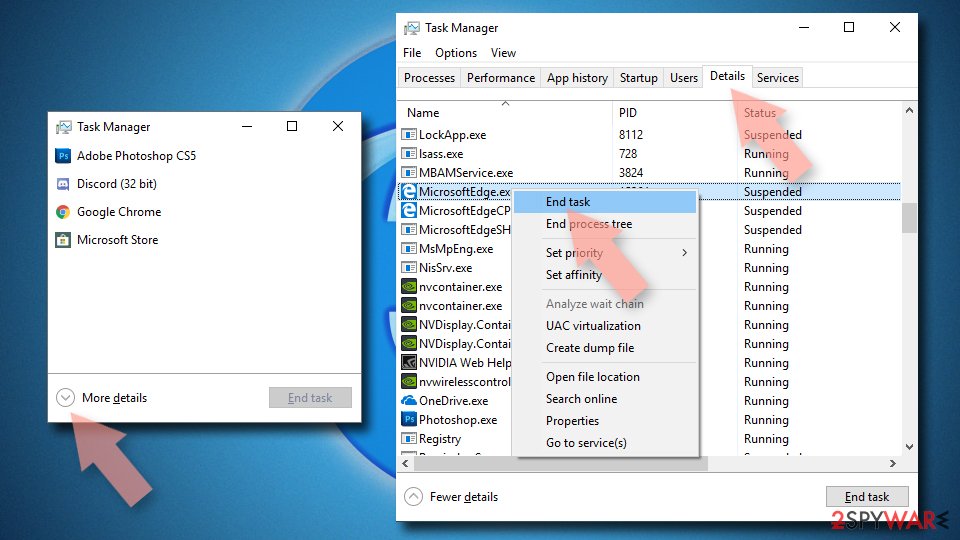
If this solution failed to help you, you need to use an advanced Edge reset method. Note that you need to backup your data before proceeding.
- Find the following folder on your computer: C:\\Users\\%username%\\AppData\\Local\\Packages\\Microsoft.MicrosoftEdge_8wekyb3d8bbwe.
- Press Ctrl + A on your keyboard to select all folders.
- Right-click on them and pick Delete
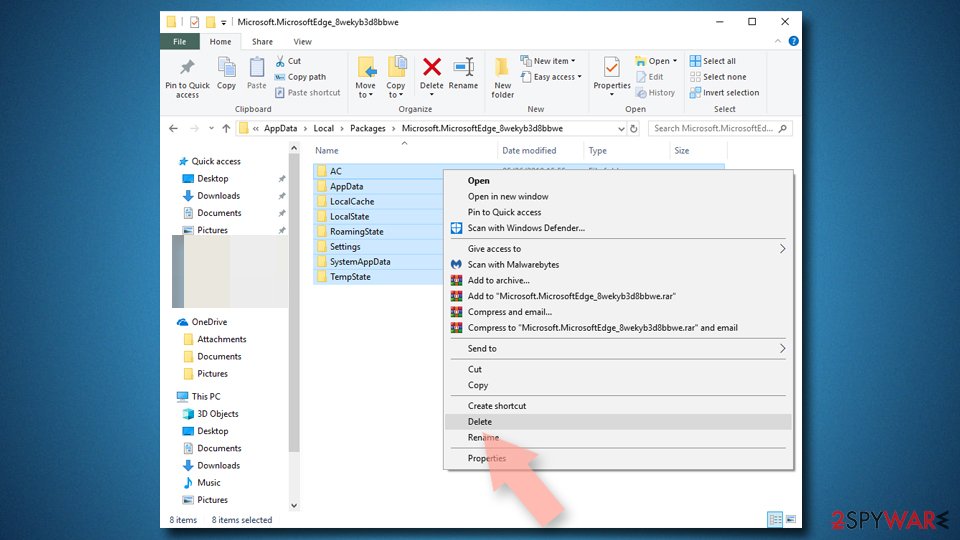
- Now right-click on the Start button and pick Windows PowerShell (Admin).
- When the new window opens, copy and paste the following command, and then press Enter:
Get-AppXPackage -AllUsers -Name Microsoft.MicrosoftEdge | Foreach {Add-AppxPackage -DisableDevelopmentMode -Register “$($_.InstallLocation)\\AppXManifest.xml” -Verbose
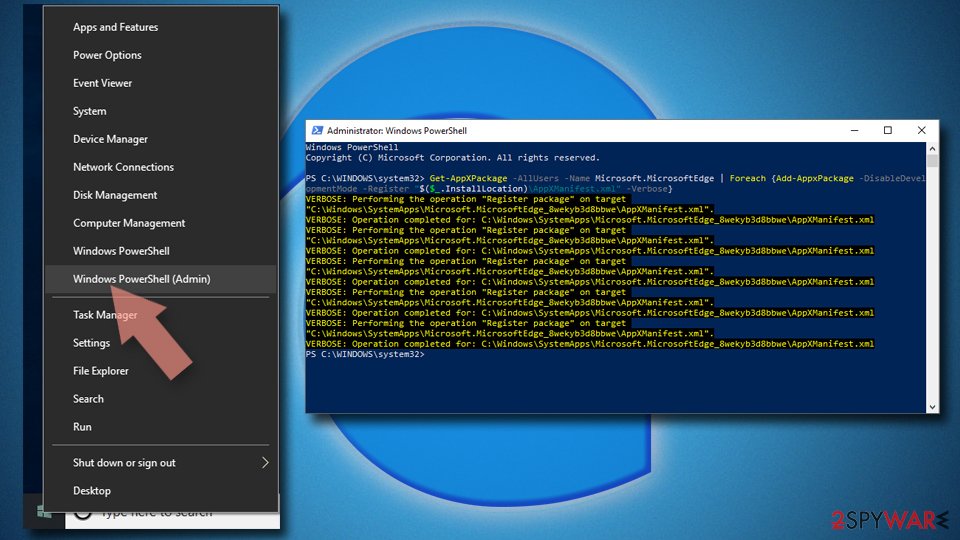
Instructions for Chromium-based Edge
Delete extensions from MS Edge (Chromium):
- Open Edge and click select Settings > Extensions.
- Delete unwanted extensions by clicking Remove.
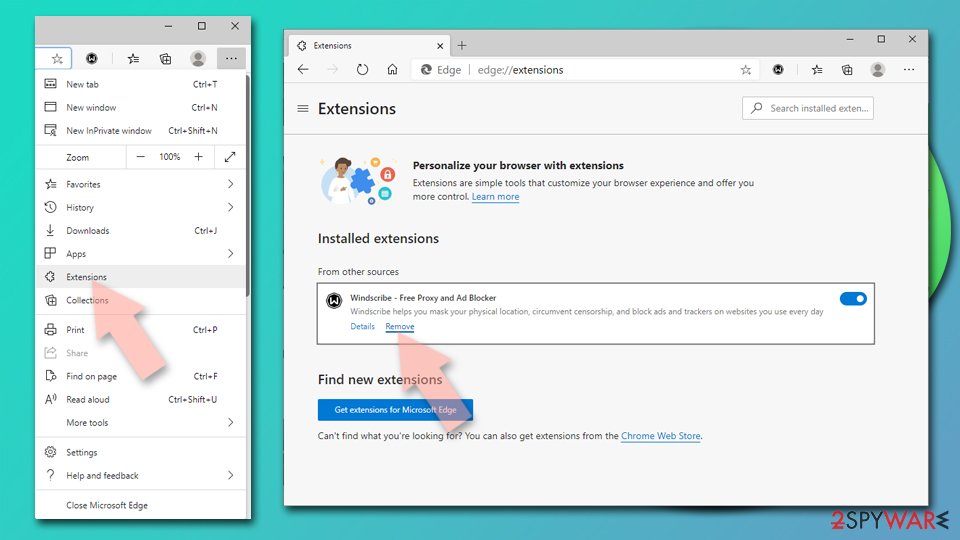
Clear cache and site data:
- Click on Menu and go to Settings.
- Select Privacy, search and services.
- Under Clear browsing data, pick Choose what to clear.
- Under Time range, pick All time.
- Select Clear now.
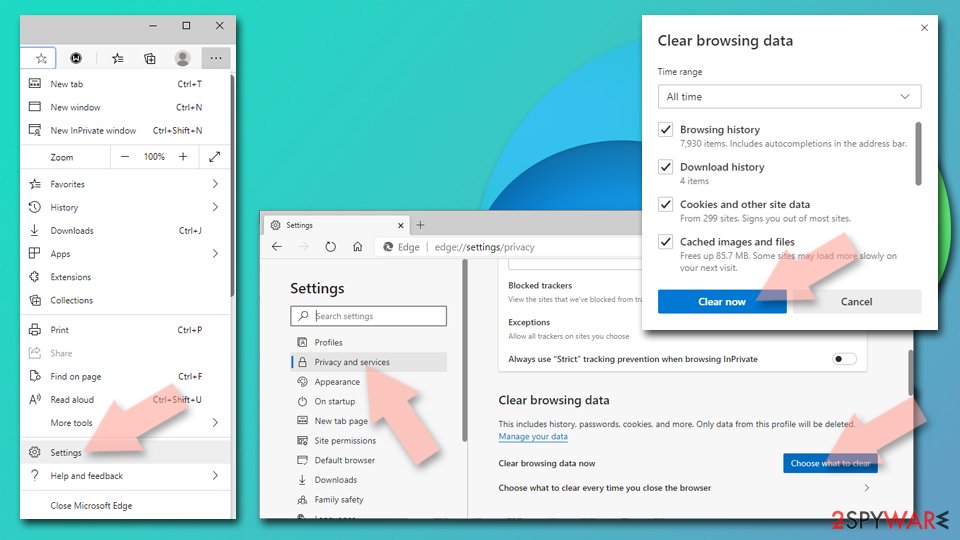
Reset Chromium-based MS Edge:
- Click on Menu and select Settings.
- On the left side, pick Reset settings.
- Select Restore settings to their default values.
- Confirm with Reset.
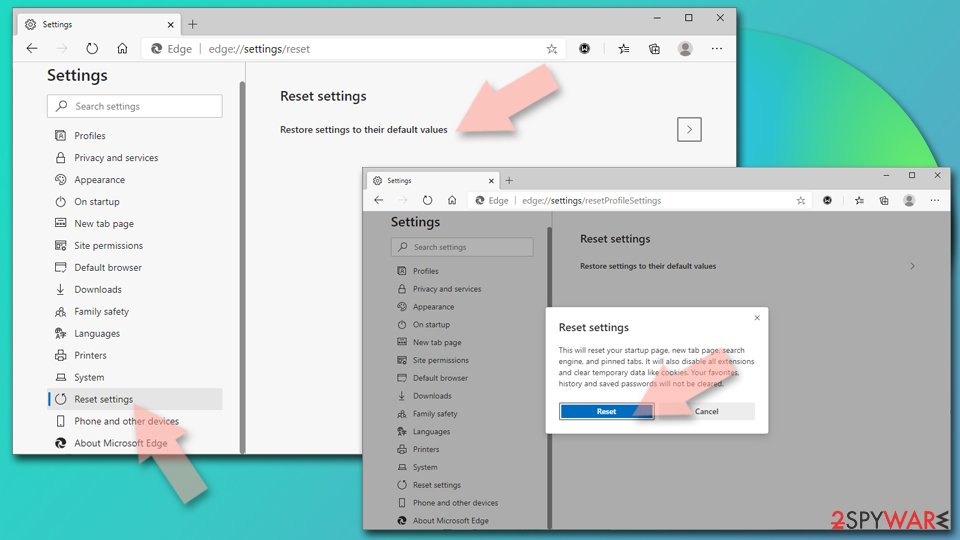
Remove from Mozilla Firefox (FF)
Remove dangerous extensions:
- Open Mozilla Firefox browser and click on the Menu (three horizontal lines at the top-right of the window).
- Select Add-ons.
- In here, select unwanted plugin and click Remove.
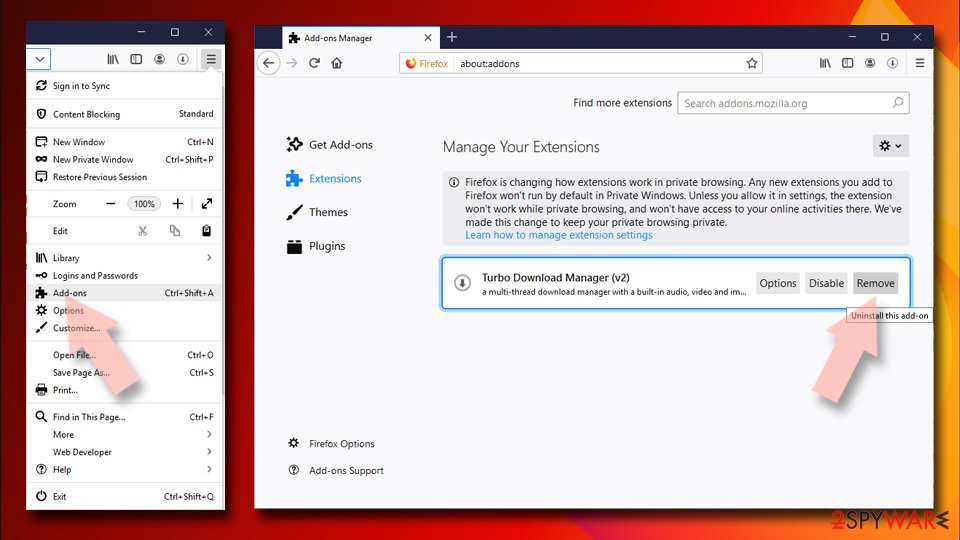
Reset the homepage:
- Click three horizontal lines at the top right corner to open the menu.
- Choose Options.
- Under Home options, enter your preferred site that will open every time you newly open the Mozilla Firefox.
Clear cookies and site data:
- Click Menu and pick Settings.
- Go to Privacy & Security section.
- Scroll down to locate Cookies and Site Data.
- Click on Clear Data…
- Select Cookies and Site Data, as well as Cached Web Content and press Clear.
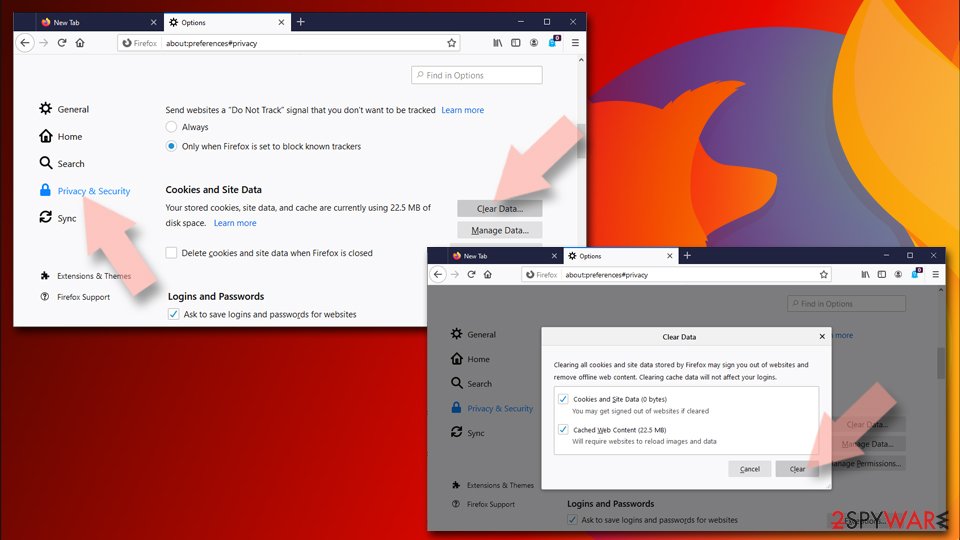
Reset Mozilla Firefox
If clearing the browser as explained above did not help, reset Mozilla Firefox:
- Open Mozilla Firefox browser and click the Menu.
- Go to Help and then choose Troubleshooting Information.
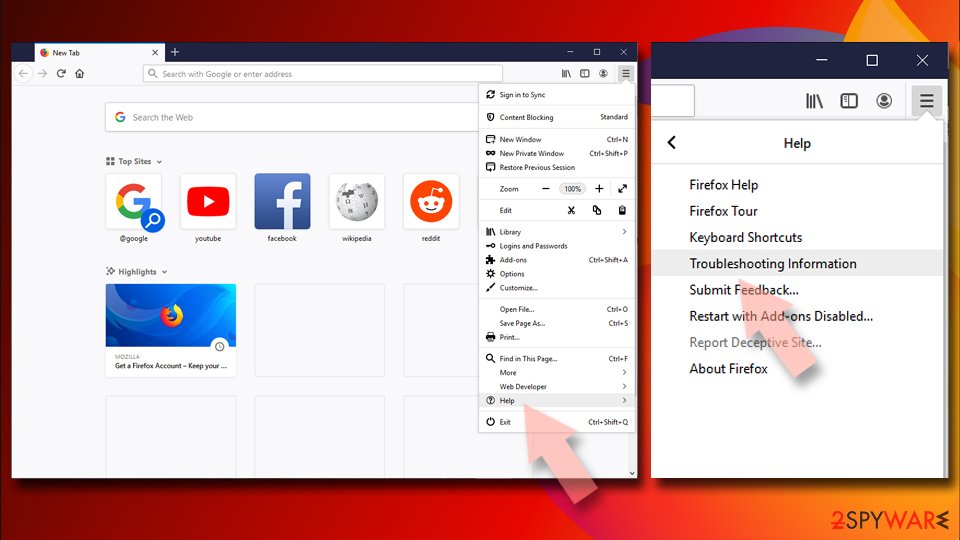
- Under Give Firefox a tune up section, click on Refresh Firefox…
- Once the pop-up shows up, confirm the action by pressing on Refresh Firefox.
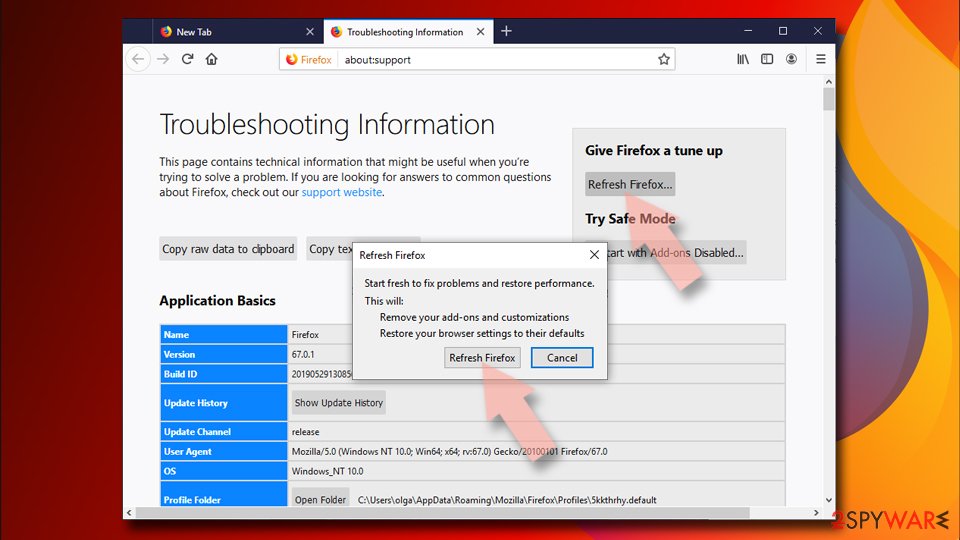
Remove from Google Chrome
When the PUP is eliminated from your system, it comes the time to kick it out of your browser as well. We explain how to do it properly in the tutorial below:
Delete malicious extensions from Google Chrome:
- Open Google Chrome, click on the Menu (three vertical dots at the top-right corner) and select More tools > Extensions.
- In the newly opened window, you will see all the installed extensions. Uninstall all the suspicious plugins that might be related to the unwanted program by clicking Remove.
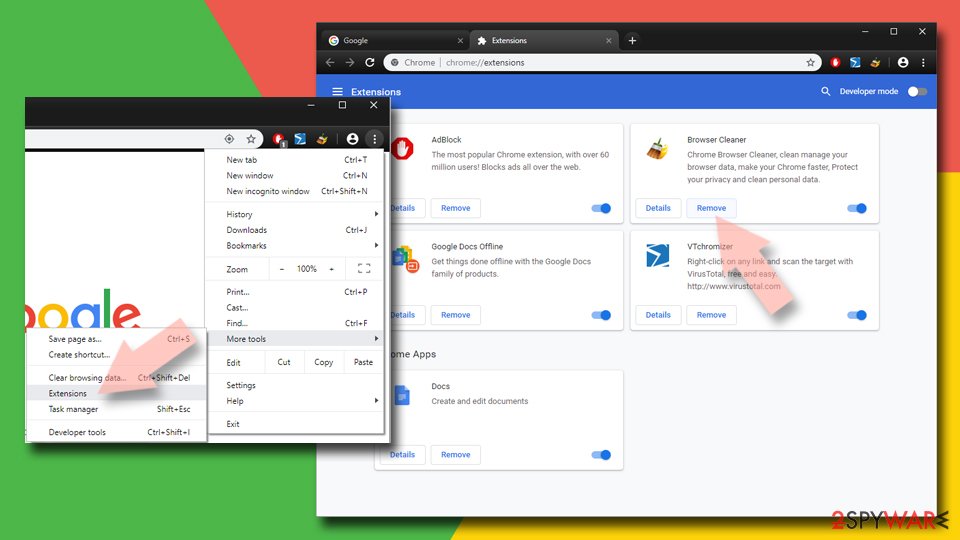
Clear cache and web data from Chrome:
- Click on Menu and pick Settings.
- Under Privacy and security, select Clear browsing data.
- Select Browsing history, Cookies and other site data, as well as Cached images and files.
- Click Clear data.
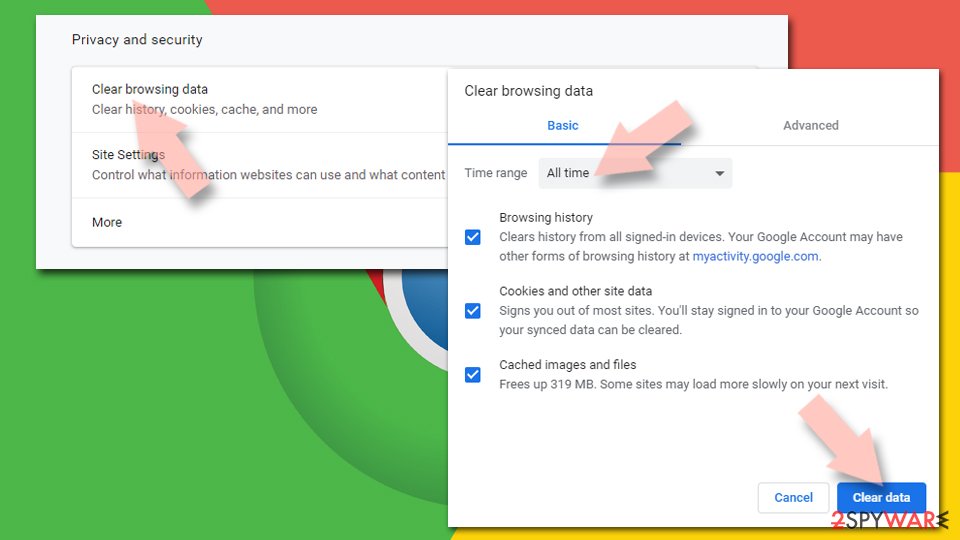
Change your homepage:
- Click menu and choose Settings.
- Look for a suspicious site in the On startup section.
- Click on Open a specific or set of pages and click on three dots to find the Remove option.
Reset Google Chrome:
If the previous methods did not help you, reset Google Chrome to eliminate all the unwanted components:
- Click on Menu and select Settings.
- In the Settings, scroll down and click Advanced.
- Scroll down and locate Reset and clean up section.
- Now click Restore settings to their original defaults.
- Confirm with Reset settings.
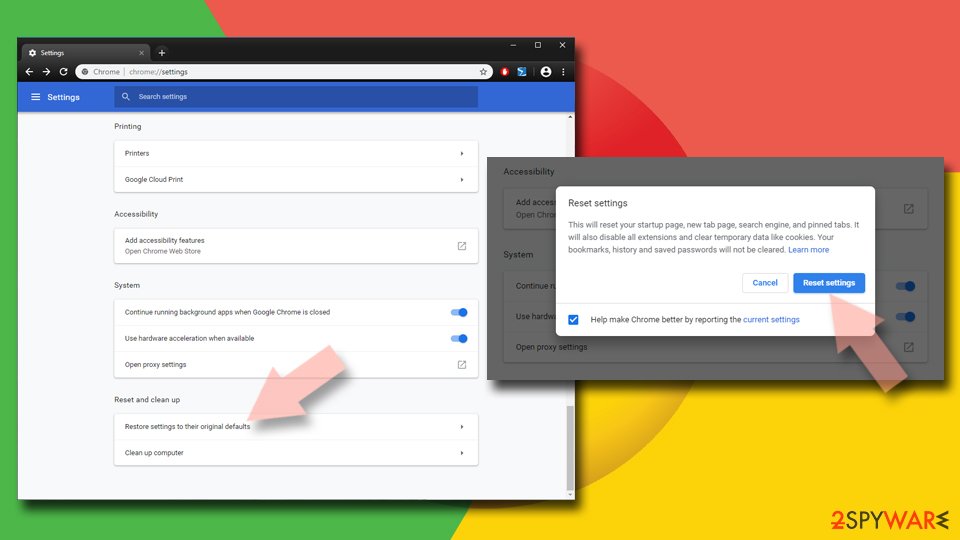
Delete from Safari
Remove unwanted extensions from Safari:
- Click Safari > Preferences…
- In the new window, pick Extensions.
- Select the unwanted extension and select Uninstall.
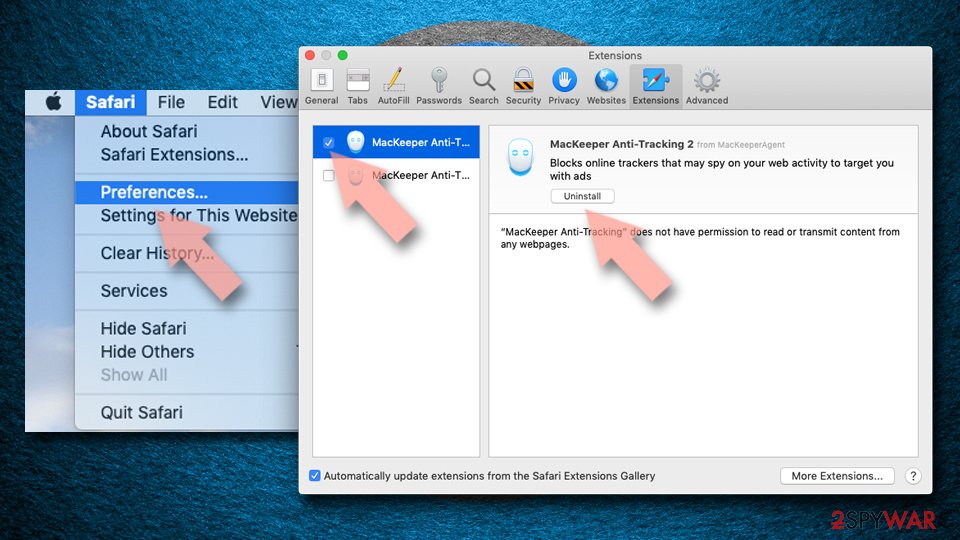
Clear cookies and other website data from Safari:
- Click Safari > Clear History…
- From the drop-down menu under Clear, pick all history.
- Confirm with Clear History.
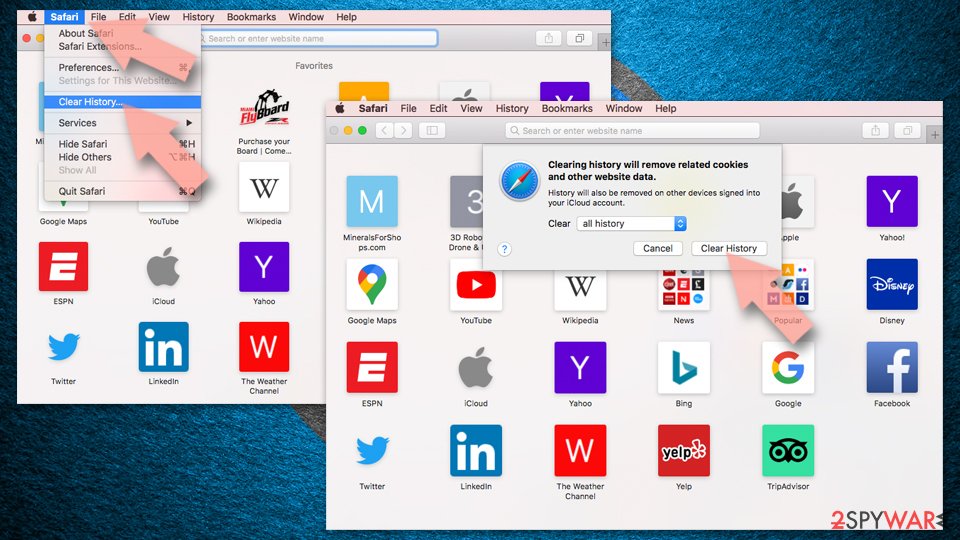
Reset Safari if the above-mentioned steps did not help you:
- Click Safari > Preferences…
- Go to Advanced tab.
- Tick the Show Develop menu in menu bar.
- From the menu bar, click Develop, and then select Empty Caches.
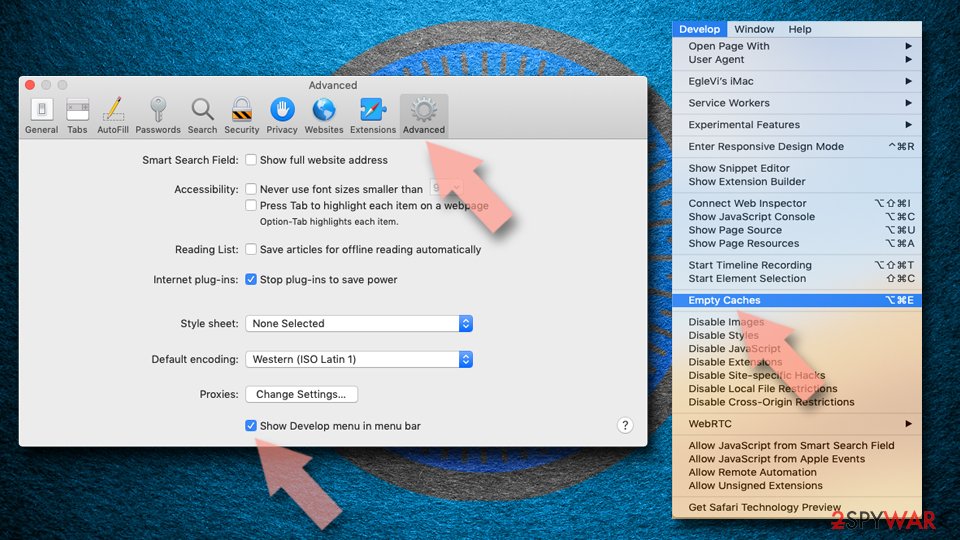
After uninstalling this potentially unwanted program (PUP) and fixing each of your web browsers, we recommend you to scan your PC system with a reputable anti-spyware. This will help you to get rid of ScanGoogle.ru registry traces and will also identify related parasites or possible malware infections on your computer. For that you can use our top-rated malware remover: FortectIntego, SpyHunter 5Combo Cleaner or Malwarebytes.
How to prevent from getting stealing programs
Stream videos without limitations, no matter where you are
There are multiple parties that could find out almost anything about you by checking your online activity. While this is highly unlikely, advertisers and tech companies are constantly tracking you online. The first step to privacy should be a secure browser that focuses on tracker reduction to a minimum.
Even if you employ a secure browser, you will not be able to access websites that are restricted due to local government laws or other reasons. In other words, you may not be able to stream Disney+ or US-based Netflix in some countries. To bypass these restrictions, you can employ a powerful Private Internet Access VPN, which provides dedicated servers for torrenting and streaming, not slowing you down in the process.
Data backups are important – recover your lost files
Ransomware is one of the biggest threats to personal data. Once it is executed on a machine, it launches a sophisticated encryption algorithm that locks all your files, although it does not destroy them. The most common misconception is that anti-malware software can return files to their previous states. This is not true, however, and data remains locked after the malicious payload is deleted.
While regular data backups are the only secure method to recover your files after a ransomware attack, tools such as Data Recovery Pro can also be effective and restore at least some of your lost data.
- ^ Custom Search Engine. Google. Make searching your site easy.
- ^ Pay Per Click business model – what they don’t say. Worldclassmedia. A Result-Based Digital Marketing SEO Ad Agency.
